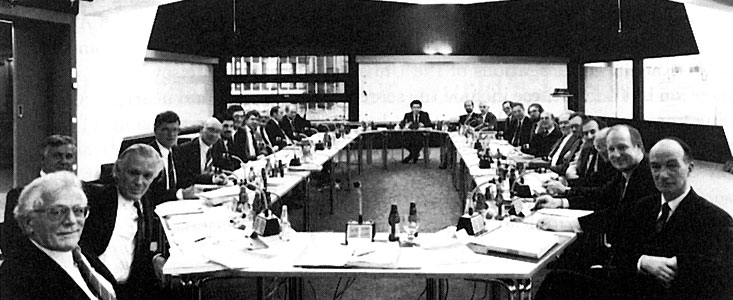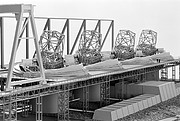Press Release
Europe Decides To Build The World's Largest Optical Telescope
8 December 1987
The representatives of the eight member states (Belgium, Denmark, the Federal Republic of Germany, France, Italy, the Netherlands, Sweden and Switzerland) agreed that the European Southern Observatory shall embark upon the realization of this marvelous instrument. This decision expresses Europe's confidence in the ambition of her astronomical community and the ingenuity of her high-tech industry; together they will ensure that Europe will be second to none in the exploration of the Universe for a long time to come. The VLT is an essential complement of Europe's astronomical research activities from space vehicles.
An ambitious project for European science and industry
Following detailed project studies (1984 - 87), it is now expected that it will take about 10 years to complete the construction, but that part of the VLT may become operational already in 1994-95. The total cost is around 382 million DM, of which 309 million is for the telescope proper and 48 million for the attached instrumentation. The rest is for the site preparation.
Exciting research opportunities
Under ESO management, and in collaboration with scientific institutions in the member countries, it is the intention that the high-tech VLT shall be constructed by European industry. Considerable technological spin-off is expected in various fields, including optics, mechanics and electronics. Once ready, the enormous telescope will be installed in the Atacama desert, at one of the best observing sites in the world, allowing European astronomers to perform new and spectacular investigations of the Universe, unparalleled elsewhere.
To mention but a few, these include the search for planets around nearby stars, the study of stars being born in interstellar clouds, and a look into the innermost regions of active galaxies which may harbour black holes at their centres. As the world's largest optical telescope, the VLT will enable scientists to probe hitherto unexplored, extremely distant regions in the Universe. Above all, its unique combination of light-gathering power and very high angular resolution will undoubtedly lead to wholly unexpected discoveries.
A new technological concept
The ESO VLT will consist of an array of 4 telescopes, each of which has a single-blank mirror with a diametre of 8 metres, resulting in a total, equivalent aperture of 16 metres. The telescopes can be used individually or combined, depending on the type of observations, giving an unprecedented degree of flexibility and greatly enhancing the observing efficiency.
All VLT mirrors will be exceptionally thin in order to reduce weight and thereby significantly save cost. ESO has recently successfully tested the principle of "active" optics, by computer controlling the surface of a thin 1 metre mirror, and this principle has also been incorporated into ESO's 3.5 m New Technology Telescope (NTT) [2], which will enter into operation at the ESO La Silla observatory in late 1988. This revolutionary concept will play a decisive role in the VLT, and will permit it to achieve a superior performance.
The technologically most advanced, auxiliary instrumentation is needed for the VLT, and a great variety of instruments will be built. Among the fields which are high on the list of priorities, one may mention: infrared imaging and spectroscopy, low resolution spectroscopy and imaging, high resolution spectroscopy and interferometry.
Site still to be chosen
The future site for the VLT has not yet been chosen. Detailed meteorological observations have confirmed the excellence of the La Silla site, but even better observing conditions may possibly be found on the top of mountains further north in the Atacama desert. Following local investigations, a promising site has been identified at Cerro Paranal, about 100 kilometres south of the town of Antofagasta. The final decision about the site is expected to be made about 3 years from now.
Remote control
Traditionally optical telescopes are used by astronomers who travel to the mountain to carry out their observations. Computer control and the latest means of satellite-borne telecommunications enable entirely new and flexible methods of telescope use. In the future, astronomers in Europe will control the VLT, with all its science options and technical possibilities at the distant South American site, from a console at the ESO Headquarters or perhaps at their home institute. ESO has already demonstrated that it is feasible to operate a telescope at a distance, and remote observing with a 1.4 m and a 2.2 m telescope on La Silla is regularly done from the ESO Headquarters in Garching near Munich, via a satellite link (eso8714).
Notes
[1] A colour brochure about the VLT is available upon request. This Press Release is accompanied by a B/W photo of a model of the VLT. (Ed. note: The photo of the ESO Council in session at the moment of this historical decision was made available the following day.).
[2] Colour photos of the NTT at the factory are available upon request. See also the ESO Messenger, No. 49, p. 36.
Contacts
Richard West
ESO
Garching, Germany
Tel: +49 89 3200 6276
Email: information@eso.org
About the Release
| Release No.: | eso8717 |
| Legacy ID: | PR 16/87 |
| Name: | Meeting, Very Large Telescope |
| Type: | Unspecified : Technology : Observatory : Telescope |
| Facility: | Very Large Telescope |


